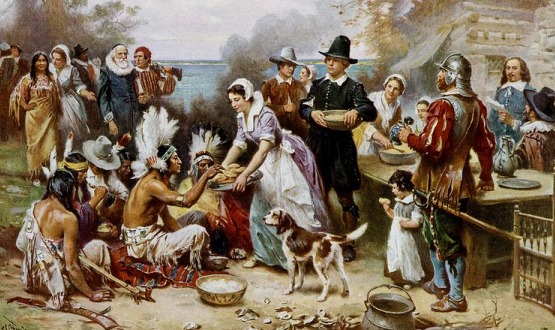Happy Turkey Day: Thanksgiving Turns 150

This Thursday, Americans will gather around groaning tables to consume massive amounts of turkey, gravy, potatoes and stuffing. It's a tradition the country associates with a Pilgrim feast in the 1600s, but actually, 2013 marks only the 150th anniversary of official Thanksgiving.
The "First Thanksgiving" taught to schoolchildren around the country dates back to 1621, when the Calvinist settlers of Plymouth Colony, better known as the Pilgrims, got together with the Wampanoag tribe for a fall harvest festival.
In fact, harvest festivals date back further than that. Spanish explorer Pedro Menendez de Aviles got together with Native Americans in St. Augustine, Fla., on Sept. 8, 1565, for a Catholic mass and a feast of thanksgiving, giving Florida a claim to the "first Thanksgiving" title. Virginia likes to claim that mantle as well: Settlers in Jamestown, Va., held a thanksgiving meal in 1607.
But it was a Yankee who made Thanksgiving into the holiday it is today, and she drew her inspiration from a Northern source. Sarah Josepha Hale was a New Hampshire novelist whose books highlighted the glories of New England; she also penned the nursery rhyme "Mary Had a Little Lamb."
During Hale's long life between 1788 and 1879, many states, especially in the north, held fall festivals of thanksgiving. It was a good time for it: The crops were in, and the livestock needed to be culled before the winter, said Andrew Smith, a culinary historian with The New School in New York City. [10 Things You Didn't Know About Food]
At a time when most holidays were religious, thanksgiving feasts were oddly secular, Smith told LiveScience.
"It was unlike every other holiday," he said. "It was family oriented and that typically meant, for the fall, that it was the kind of harvest festival that had been celebrated in England."
Sign up for the Live Science daily newsletter now
Get the world’s most fascinating discoveries delivered straight to your inbox.
Various New England states set their own thanksgiving dates throughout the 1800s, but Hale was largely responsible for getting the whole nation on board. She began advocating for a national holiday of Thanksgiving in 1846, lobbying presidents Zachary Taylor, Millard Fillmore, Franklin Pierce and James Buchanan to no avail. Finally, in 1863, Hale hit pay dirt with Abraham Lincoln, who was moved by her words and by a desire for unity after the Civil War to declare the fourth Thursday in November Thanksgiving Day.
"Thursday was a good day," Smith said. "Nothing was happening."
Hale's novels and articles are also responsible, in part, for the menu and myths surrounding Thanksgiving today. She associated the holiday with the Pilgrims and rhapsodized about turkey as the centerpiece of the meal. Cranberries and pumpkins, which are northern crops, likewise highlight this holiday's Yankee roots.
In fact, Thanksgiving was initially so associated with the North that Southerners, embittered by the Civil War, took some time to warm to the proceedings, Smith said. But as new immigrant groups poured into the United States over the next century, Thanksgiving became a way to communicate the American creation myth to these new groups.
In some ways, Thanksgiving sends modern Americans back to those roots: Everyone eats certain dishes, like whole roast turkey, considered too troublesome for everyday cooking today. Even the typical pattern of feasting on Thanksgiving day hails back to how people ate on a daily basis 150 years ago: A relatively large breakfast, a large meal at 2 p.m. or so, and then an extremely small supper.
"The meal pattern changed because of the industrialization of America, so the big meal became supper at dinner," Smith said. "But holidays in general, Thanksgiving in particular, retains that initial pattern."
In a calendar coincidence, the 150th Thanksgiving also falls at the same time as Hanukkah.
Follow Stephanie Pappas on Twitter and Google+. Follow us @livescience, Facebook & Google+. Original article on LiveScience.

Stephanie Pappas is a contributing writer for Live Science, covering topics ranging from geoscience to archaeology to the human brain and behavior. She was previously a senior writer for Live Science but is now a freelancer based in Denver, Colorado, and regularly contributes to Scientific American and The Monitor, the monthly magazine of the American Psychological Association. Stephanie received a bachelor's degree in psychology from the University of South Carolina and a graduate certificate in science communication from the University of California, Santa Cruz.










